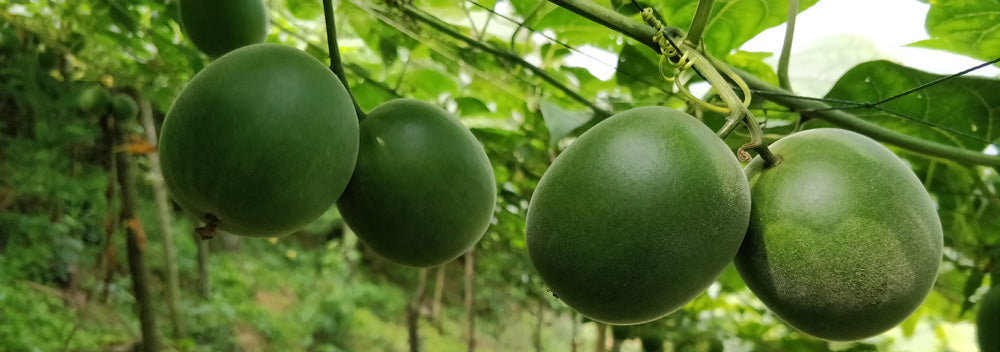What is Monk Fruit?
Monk fruit (also known as Siraitia Grosvenorii or Luohan Guo) is a small sub-tropical melon that has been cultivated in the remote mountains of Southern China for centuries. According to legend, monk fruit is named after the Buddhist monks who first cultivated the fruit nearly 800 years ago.
Monk fruit thrives almost exclusively in China and bears fruit resembling a lemon in size and shape. The Guilin region, with its subtropical mountainous terrain at elevations of 300 to 500 meters, ample rainfall, and moist, well-drained soil, provides an ideal cultivation environment for this plant.
Why is Monk Fruit used as a Sweetener?
It’s no secret that fruits are sweet, and that’s because they contain sugar. Bananas, strawberries, apples, grapes… they are all sweet and they all contain sugar. Monk Fruit is no exception.
However, there’s one thing that makes Monk Fruit different… Mogrosides.
Monk fruit contains sweet chemical compounds known as mogrosides. These mogrosides, identified as I, II, III, IV, V, and VI, are found in varying concentrations, ranging from 0.5% to 3.8% in the dried fruit. Out of all of those, Mogroside V is by far the sweetest… up to 250 times sweeter than regular sugar!
Mogroside V (MV) is what makes Monk Fruit special. It’s very sweet and it has no calories or glycemic impact.
The industry figured out how to extract Mogroside V from large quantities of monk fruit, and this (coupled with increasing consumer awareness) led to mass adoption of monk fruit as a sweetener.
However, you might be wondering… “if this is true… how come the monk fruit sweetener I buy at the store is not up to 250X sweeter than sugar?”
Great question! Let’s break this down…
Extracts vs Extracts+Fillers
There’s two main categories of monk fruit sweeteners:
Extracts:
These are extracts of the monk fruit, nothing else. The monk fruit is refined (removed from impurities) to reach different levels of Mogroside V (MV) concentration. The end product can be either in liquid or powder form, and the MV concentration can vary highly depending on the process, from as low as 2% to as high as 80%. The higher the MV concentration, the sweeter the product.
Extracts are ideal when the only goal is to sweeten something. They are perfect to replace sugar in drinks, like coffee and tea. However, they are not recommended for baking, for example, where you might also need to substitute the texture that sugar provides. If you want your sugar-free cupcakes to be fluffy, stay away from extracts and consider using a blend of Extracts+Fillers.
Extracts+Fillers:
Monk Fruit extracts (which are very sweet) are blended with fillers, like Erythritol and Allulose, (which are less sweet than sugar) to create a 1:1 sugar replacement. These blends are marketed as monk fruit sweeteners but they contain less than 1% of monk fruit extract, the rest is just fillers.
If this takes you by surprise, you are not alone. Most companies are not very transparent in their marketing when it comes to this. However, to be fair… it doesn’t mean that the product itself is bad. These extract+fillers blends make it possible to replace not only the sweetness but also the texture of sugar. It might not make sense to sweeten your coffee with a blend, but it makes 100% sense to use as a sugar substitute in your next brownie recipe.
Conclusion
Monk fruit is a small melon native to Southern China. It is known for its sweet compounds called mogrosides, particularly Mogroside V, which is up to 250 times sweeter than sugar, all while having no calories or glycemic impact.
Monk fruit sweeteners come in two main types: pure extracts, offering high sweetness with varying Mogroside V concentrations, and blends with fillers like Erythritol and Allulose, designed to replicate sugar's sweetness and texture.
Pure extracts are ideal for drinks, while blends are ideal for baking, where you not only want to replace sugar's sweetness but also its texture.


Share:
Understanding the Role of Erythritol in Monk Fruit Sweeteners